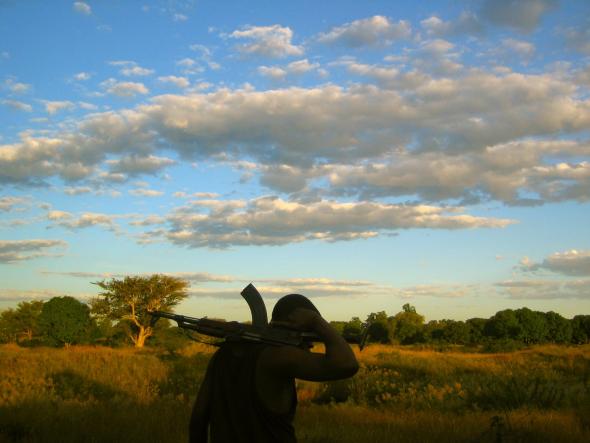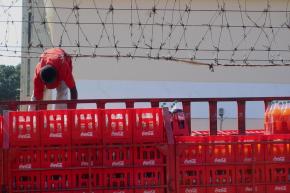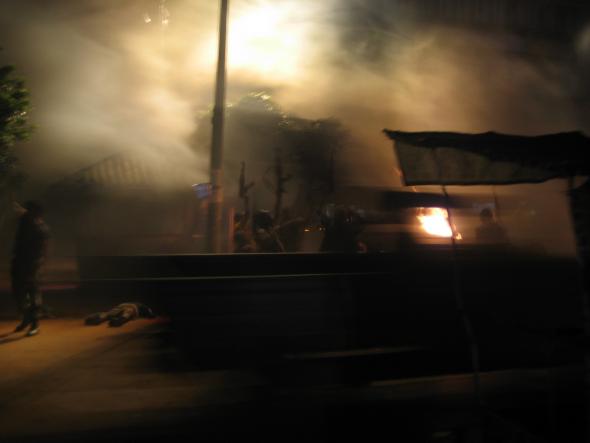Kalashni-Coke
In the country with a Kalashnikov in its flag we were walking a long way to meet a musician and record some of his tunes for the soundtrack to a documentary. Tobias Dzandiwandira is a practically unknown talent, for he lives with his large family an hour and a half away from the nearest road in Mozambique’s centre-west, close to the border with Zimbabwe.
We’re guided along the trails by another musician, stage name: Kidmore France – a young man who works in G Som Radio, an NGO financed community radio in Chimoio, the city where we have been basing ourselves. It’s very hot; Kid had told us that Tobias didn’t live far, but that’s known to be relative. It’s better now to think we keep on our morning stroll, even if it has turned into a long walk by noon, when the shadows grow shorter and the yards grow longer.
Step by step, the heat, the silence and the path take hold of us.

A small commercial stall at an intersection justifies a break. The vendor smiles; it isn’t everyday such a group passes by, four blacks and two whites carrying non-identifiable material and a blue cooler bag. The stall has few products to sell, just the usual in such outcast places: oil, salt, batteries, soap, matches and Coke, refreshment served at ambient temperature. We buy nothing as we brought all we need from the city, but dialogue is also commerce and we stay exchanging conversation. Incidentally, the vendor says he keeps a Kalashnikov in there, although he doesn’t show it. The region is at peace and the volume of business does not justify the weapon, but there are objects that become part of life, even when they are no longer necessary.
In front of the stall, split from its herd, a military tank points to the past. War spoils that lost their battle against rust and history’s erosion.
It is said that the United States of America gave Coca-Cola to the world, and the Soviet Union the Kalashnikov. Africa can’t deny it. Both perfectly adapted, each one in it’s own way, to the continent’s geography and socio-political terrain. Thus we can find specimens of either of them at the entrance of a fashionable shopping centre or in the most remote place.
So much familiarity with the world’s most popular weapon gave origin to the diminutive AK-47, simpler and expressing more intimacy than Avtomat Kalashnikova 1947. Over decades, this gun found an endless market in the African conflicts: from the independence struggles to the Coups d’état. The Kalash serves the emergent rebel group or the muscled dictatorship. It stands for both sides in all kinds of conflicts, with no prejudice against any religious beliefs or political ideologies; the AK empowers bandits and private security firms’ guards.
When the Cold War ended, vast warlike arsenals were left in a vocational crisis, and in haste, a solution was found: Africa. After the fall of the Berlin Wall, the continent was deluged with more and more weapons, an exported artificial catastrophe including end of season discounts. Selling the old toys of new republics, cashing in for generals, ex-soviets and ex-socialists turned businessman, providing horror abroad.
Coke is sold in all the 53 African countries, with this continent representing 7% of the company’s global sales. It doesn’t look much, but according to Neville Isdell, Coca-Cola’s ex-CEO, it is the area of the globe with the biggest sales growth, therefore the main bet for the multinational. Its successful formula thrived as in the rest of the world – export the elixir and all you have to do is add water and gas before tapping it.
 Each one with its own tricks and secrets, as in business silence is golden, both Coca-Cola and the Kalashnikov were spread throughout the continent as a fire on a dry windy night. Even where there is no cell phone signal or electricity, it’s possible to find these design icons of the 20th Century. In some African regions, these weapons and soft drinks are still more common than a radio or a bicycle, more accessible than schoolbooks, drinkable water and medicines, mosquito nets or latrines. During the genocide in Rwanda, in 1994, there were more Kalashnikovs in the country than automobiles and bicycles put together.
Each one with its own tricks and secrets, as in business silence is golden, both Coca-Cola and the Kalashnikov were spread throughout the continent as a fire on a dry windy night. Even where there is no cell phone signal or electricity, it’s possible to find these design icons of the 20th Century. In some African regions, these weapons and soft drinks are still more common than a radio or a bicycle, more accessible than schoolbooks, drinkable water and medicines, mosquito nets or latrines. During the genocide in Rwanda, in 1994, there were more Kalashnikovs in the country than automobiles and bicycles put together.
For its important role in achieving the country’s independence, Mozambique keeps its Kalashnikov in the national flag, together with a hoe and a book. So far, no country exhibits the Coke logo in its flag, but the world hasn’t seen everything yet. We’re probably closer to that glamorous ceremony, amidst dust, black cars and goats, optimistic speeches and commotion: a prestige label rescuing a State in dire straits. Somalia would be a qualified candidate. Coca-Cola executives taking over the real seats of Government: CEOs, assessors, annalists, consultants and specialists united to pacify and manage a chaotic country. Self-confident young managers, selling their pragmatism based upon PowerPoint presentations combining entrepreneurial prowess with multimedia. Reasoning with warlords, regional and religious factions and the arms dealing mafia. A fiasco? As we saw 20 years ago with the military intervention in Somalia.

The children play around the clothes hanging on the washing line. Sitting in the backyard, old Tobias Dzandiwandira is playing his m’bira and singing – “If you want to court that woman, ask her neighbour”. He lives in the middle of the bush, unaware of the acrimonies of a condo meeting, but it seems to me that he knows about international law.
Published in Fugas Magazine of Público newspaper in October 2008